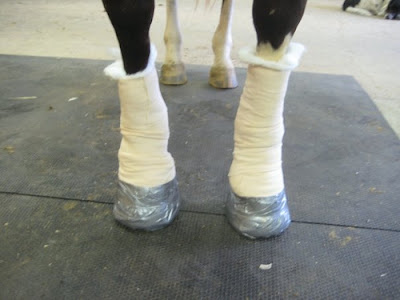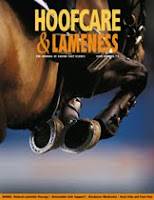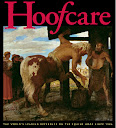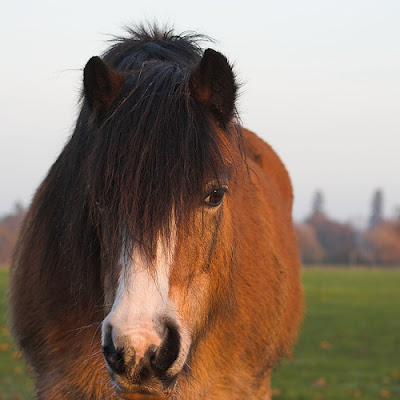 |
| Great Britain's Princess Royal addressed the National Equine Forum, where new statistics on horse health were presented. |
The 19th National Equine Forum (NEF), held in Great Britain on March 8, 2011, was the launch pad for the results of the United Kingdom’s first public National Equine Health Survey. The event was attended by over 200 of the country’s most influential members of the equestrian industry, including NEF President HRH The Princess Royal, leading equine vets, international riders and trainers, equestrian society figureheads, business leaders and numerous members of the equestrian trade industry.
 |
| Josh Slater, Professor of Equine Clinical Studies at the Royal Veterinary College and immediate past president of the British Equine Veterinary Association (BEVA), announced the results of the survey, which was pioneered by The Blue Cross animal charity and is supported by BEVA. The survey was conducted in November 2010. |

The results were announced at the Forum by Professor Josh Slater, Professor of Equine Clinical Studies at The Royal Veterinary College, who has been working with The Blue Cross on the survey.
Analyzed data from the study will be used to pinpoint current, non-notifiable healthcare issues affecting horses, ponies, donkeys and mules in the UK and is expected to break new ground for all of Europe as well.
Professor Slater explained that the survey should provide a future benchmarking facility for equine disease, welfare, standards of care and codes of practice and it has also confirmed the workability of an important template to monitor the serious threat of infectious and exotic disease in the future.
 |
| Laminitis cases still abound in Great Britain; this dramatic photo of a medial sinker from the case files of farrier Jim Ferrie FWCF is evidence of that. Jim provides consulting services at the University of Glasgow's Wieper Equine Hospital. (Jim Ferrie photo) |
A total of 306 sets of records were submitted from 3120 horses in mainly private ownership, with a balance of representation from competition yards, riding schools, welfare charities and studs. A broad range of syndromes and diseases were assessed including colic, sarcoids, laminitis, wounds, dental issues, eye disease, lameness and weight issues.
Equine lameness statistics also figure prominently in the survey and show some variation from oft-quoted statistics about soundness problems in horses.
The results showed that lameness was the most common problem affecting horses (11% of horses surveyed) but that, unexpectedly, the foot was
not the most common cause of lameness and that laminitis (3%) was less common than the 7-8% total that previous surveys had suggested.
Weight management was the next most common issue for horse owners, with 9% of horses recorded as overweight and 8% as underweight.
The new statistics are not far from those compiled in the study
Equine laminitis in the new millennium: frequency, risk factors and assessing a potential new therapy by Claire E. Wylie et al, presented at the 2009 meeting of the Society for Veterinary Epidemiology and Preventive Medicine. Wylie found that laminitis cases contributes to between 0.11‐28.57% of all equine visits analyzed by veterinarians who participated in her study, with a mean of 5.03% and a median of 3%.
The most often quoted statistics from Britain are from Hinckley and Henderson's 1996 paper presented at the 35th Congress of the British Equine Veterinary Association. (See Hinckley, K.A. and Henderson, I.W. 1996.
The epidemiology of equine laminitis in the UK in the
35th BEVA Annual Congress Proceedings) That paper stated:
From a study involving 113,000 horses in the UK it was estimated that the total prevalence of acute laminitis in the UK was over 8,000 cases annually, giving a prevalence of 7.1%.
Anyone who reads this blog knows enough to see little red flags popping up right away: there is a big difference in a study like Hinckley's that tracks cases of
acute laminitis with a study of
all cases of laminitis, like the National Equine Health Survey's, as reported by horse owners.
 |
| Many horses who suffer from mild chronic laminitis never get treated and may never even have an official diagnosis. (VetMoves photo) |
Another study that is often quoted found a much higher prevalence of laminitis in Great Britain around the same time. Katz surveyed the health of horses at a large charity farm with a population of 1140 horses and ponies, and found an average of 148 episodes of laminitis (prevalence of 13%) occurring each year (between 1997 and 1999), involving 113 animals.
(See Katz L, DeBrauwere N, Elliott J, Marr C, Pfeiffer D.
The prevalence of laminitis in one region of the UK in
Proceedings of the 40th British Equine Veterinary Association Congress.)
None of these statistics really add up. I have often heard Katz's 13% quoted as the nationwide prevalence of laminitis in the UK, when he was actually studying a population of horses that might rightfully be expected to have some sort of laminitis, related to age or neglect circumstances that required their removal to a charity farm. Were those horses a suitable population to use as a sample of the entire national population of horses?
Hinckley's statistics have always been shocking, considering that she was documenting strictly acute cases. Wylie's study, presented as a poster at the conference, does not specify how laminitis was defined. Having her statistic closely matched by the much larger population sampled by the National Equine Health Survey's is encouraging, if their parameters were similar.
That said, a lot depends on when a survey is conducted. Some years have much higher numbers of cases because of weather conditions that encourage grass-related laminitis. The problem with this study's result is that it is tempting to say that education, medication and horse-owner awareness are kicking in and more horses are avoiding laminitis than in the past. But then we immediately see that 9% of the horse population is overweight, and can only wonder if that figure is up or down from previous periods. If that number is down as well, then all the hard work of vets, farriers, feed companies and charities is having an effect and horses in Great Britain are in a lot less pain now than they were 15 years ago. Maybe.
Here's a brief slide show summarizing the National Equine Health Survey in Great Britain (click on right to advance slides):
An interesting extrapolation from the study is that 18 percent of the horses had a problem with weight management (either under- or overweight) vs 11 percent who had suffered from lameness. It's possible that the actual weight problem is much higher, since the statistic allowed the owner to judge his or her own horses' weight suitability.
To clarify the location of lameness: it may sound like news that lameness in the foot was lower than expected, but it should be made clear that lameness location was divided into three groups: foot (3.7%), non-foot (4.5%), and laminitis (3%). If you consider laminitis a lameness of the foot, the combined total would be quite a bit higher than non-foot sources of lameness. However, for the purposes of the study, the statisticians were probably trying to keep their categories separate.
Meanwhile, the British Horse Society reports that its 2011 Laminitis Conference, planned for the end of this month in conjunction with Dodson and Horrells, has been sold out and no more registrations can be accepted.
It's so difficult to compare statistics from different studies or to say that one is the definitive measurement of the most pressing equine health issues. It sounds like the new National Equine Health Survey could be on its way to being the one-stop source for horse health statistics in Great Britain. While it's easy to wonder about the validity of horse owners' judgments about things like their horses' conditions, it's more productive to congratulate the Blue Cross and BEVA for undertaking such a massive effort, and for getting it done. And, most of all, for making the results available to the public. Thank you!
About the Forum: The National Equine Forum is chaired by Professor Sir Colin Spedding and is convened by Miles Williamson-Noble. It is usually attended by HRH The Princess Royal, its President, and is supported by the Association of British Riding Schools, Bedmax, The Blue Cross, British Equestrian Federation, British Equestrian Trade Association, British Equestrian Veterinary Association, British Horse Society, British Horseracing Authority, Bulley Davey, Darby’s Solicitors, Dodson and Horrell, Donkey Sanctuary, Equine Products UK, Horse Trust, Jeffress Scholarship Trust, NFU Mutual Insurance, South Essex Insurance Brokers, Weatherbys and World Horse Welfare.
Photos of The Princess Royal and Professor Slater courtesy of the National Equine Forum/Craig Payne Photography.
© Fran Jurga and Hoofcare Publishing; Fran Jurga's Hoof Blog is a between-issues news service for subscribers to Hoofcare and Lameness Journal. Please, no use without permission. You only need to ask. This blog may be read online at the blog page, checked via RSS feed, or received via a digest-type email (requires signup in box at top right of blog page). To subscribe to Hoofcare and Lameness (the journal), please visit the main site, www.hoofcare.com, where many educational products and media related to equine lameness and hoof science can be found. Questions or problems with this blog? Send email to blog@hoofcare.com.
Disclosure of Material Connection: I have not received any direct compensation for writing this post. I have no material connection to the brands, products, or services that I have mentioned, other than Hoofcare Publishing. I am disclosing this in accordance with the Federal Trade Commission’s 16 CFR, Part 255: Guides Concerning the Use of Endorsements and Testimonials in Advertising.





















 I
I 